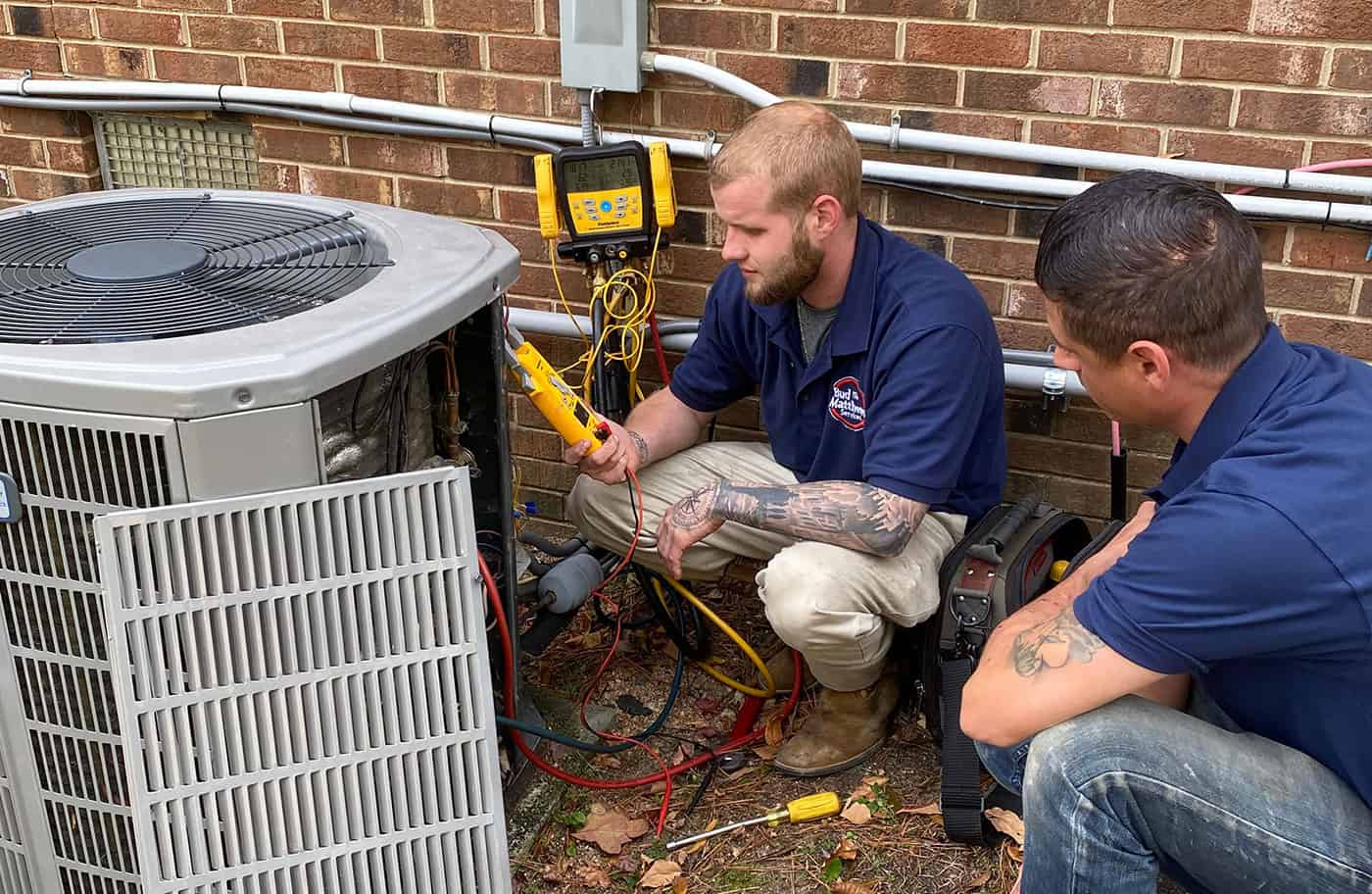Why Your Furnace Is Not Blowing Hot Air
The Importance of a Well-Functioning Furnace
A well-functioning furnace is crucial for maintaining a comfortable indoor environment, particularly during the colder months. A malfunction can significantly impact your comfort and safety. It not only keeps you warm but also contributes to the overall energy efficiency of your home, which is why isn’t your furnace blowing hot air is a problem you need to address promptly.
When your furnace stops blowing hot air, it’s more than just an inconvenience—it can lead to a significant drop in comfort and may indicate deeper issues within your heating system. Understanding why isn’t your furnace blowing hot air is the first step toward maintaining a warm and comfortable home. The next step is to hire a professional like Bud Matthews Services who can assist you with issues with your furnace.
Common Issues with Furnaces
Signs Your Furnace Is Malfunctioning
Recognizing the early signs of a malfunctioning furnace can help prevent more severe issues. If your furnace is making strange noises, frequently cycling on and off, or failing to maintain a consistent temperature, these could be indicators that something is wrong. These issues are often precursors to more significant problems, such as why isn’t your furnace blowing hot air.
The most obvious sign, of course, is when the furnace stops blowing hot air altogether, which is a clear indication that something needs immediate attention. Addressing these signs early, especially with the help of a professional like Bud Matthews Services, can prevent a complete system failure and ensure that your furnace continues to operate efficiently.
Understanding How a Furnace Works
The Basics of Furnace Operation
A furnace operates by generating heat, usually through the combustion of gas or the use of electric heating elements, and then distributing that heat throughout your home via a system of ducts. The furnace’s blower motor plays a critical role in pushing the warm air through the ducts and into the various rooms of your home. If any part of this process fails, you might find yourself asking, “Why isn’t your furnace blowing hot air?” Understanding the basic operation of your furnace can help you pinpoint where things might be going wrong and why isn’t your furnace blowing hot air. If you are unsure on how your furnace actually operates, it is best to seek the help of experts such as Bud Matthews Services.
Components of a Furnace
Several components work together to ensure your furnace operates smoothly. Understanding these can provide insight into where issues might arise when your furnace isn’t blowing hot air. These components include the heat exchanger, blower motor, and thermostat, all of which play crucial roles in the heating process. If any of these components fail, it can lead to a situation where you’re left wondering why your furnace isn’t blowing hot air. By understanding the function of each component, you can better appreciate the complexity of your furnace and the importance of regular maintenance. Professionals such as Bud Matthews Services can also be a big help. They can make you fully understand the components your furnace has and why they could contribute to the reason why your furnace is not heating.
Heat Exchanger
The heat exchanger is a critical component that transfers heat from the combustion process to the air that will circulate through your home. If the heat exchanger is damaged or not functioning properly, your furnace may produce less heat or none at all, which could be a key reason why isn’t your furnace blowing hot air. The heat exchanger’s condition is vital for efficient furnace operation and for ensuring that the furnace can generate and distribute heat effectively throughout your home. A compromised heat exchanger is a common reason why isn’t your furnace blowing hot air, making regular inspections essential.
Blower Motor
The blower motor is responsible for moving the warm air generated by the furnace through the ducts and into your home. If the blower motor isn’t working, the furnace can’t distribute hot air, even if it’s generating heat, which is a primary reason why isn’t your furnace blowing hot air. The blower motor’s role is critical in ensuring that the heat produced by the furnace reaches all areas of your home, maintaining a comfortable indoor environment. A malfunctioning blower motor is often at the heart of the issue when your furnace stops blowing hot air, underscoring the importance of this component in the heating process.
Thermostat
The thermostat controls when your furnace turns on and off based on the temperature settings you choose. If the thermostat isn’t working correctly, it may prevent the furnace from turning on or cause it to blow cold air instead of hot, leading to the question of why isn’t your furnace blowing hot air. The thermostat’s functionality is crucial for the proper operation of your furnace, as it directly influences the system’s ability to maintain the desired temperature in your home. A faulty thermostat is a common reason why isn’t your furnace blowing hot air, making it an important component to monitor.
Common Reasons Your Furnace Isn’t Blowing Hot Air
Thermostat Issues
The thermostat is often the first place to check when your furnace isn’t blowing hot air. Issues with the thermostat are a common reason why isn’t your furnace blowing hot air, and they can often be resolved with simple adjustments or repairs.
Incorrect Thermostat Settings
In some cases, the problem may be as simple as incorrect thermostat settings. Make sure that the thermostat is set to “heat” and that the temperature is set higher than the current room temperature. Incorrect settings are a frequent reason why isn’t your furnace blowing hot air, and adjusting the thermostat can often restore proper function.
Faulty Thermostat
If the thermostat is correctly set but your furnace still isn’t blowing hot air, there may be an issue with the thermostat itself. This could involve wiring problems or internal failures that prevent it from communicating properly with the furnace. A faulty thermostat is a common reason why isn’t your furnace blowing hot air and+-/ addressing it can help restore your home’s warmth.
How Dirty Filters Affect Furnace Performance
Pilot Light or Ignition Problems
Gas Supply Issues
If the pilot light is out or if there is an issue with the gas supply, the furnace will not be able to generate heat. This could be due to a closed valve, a problem with the gas line, or an issue with the pilot light itself. Gas supply issues are a common reason why isn’t your furnace blowing hot air, and resolving these issues is essential for restoring your furnace’s functionality.
Ignition Control Issues
If the ignition system fails, the furnace won’t be able to light the burners, preventing it from producing hot air. This can happen due to issues with the ignition control module, which may require attention to restore proper function. Ignition control issues are another reason why isn’t your furnace blowing hot air, making it important to ensure that this component is functioning correctly.
Blower Motor Problems
Blower Motor Malfunction
The blower motor is essential for circulating the heated air throughout your home. If it malfunctions, the furnace may produce heat, but it won’t be able to distribute that heat, leading to the question of why isn’t your furnace blowing hot air. Blower motor issues can stem from wear and tear, lack of maintenance, or electrical problems, all of which can prevent your furnace from blowing hot air.
Electrical Issues
The blower motor and other furnace components rely on electricity to operate. If there’s an electrical problem—such as a tripped breaker, blown fuse, or faulty wiring—the blower motor might not work, leaving you without hot air. Electrical issues are a common reason why isn’t your furnace blowing hot air, and addressing these problems is key to restoring your furnace’s function.
Overheated Furnace
Causes of Furnace Overheating
A furnace can overheat for various reasons, including blocked airflow due to clogged filters, malfunctioning blower motors, or issues with the heat exchanger. When a furnace overheats, it will typically shut down to prevent damage, which can result in a lack of hot air. Overheating is a common reason why isn’t your furnace blowing hot air, and understanding the causes of overheating can help prevent it from happening.
Safety Mechanisms in Place
Modern furnaces are equipped with safety features designed to prevent overheating from causing damage. These mechanisms may include automatic shut-offs, which, while essential for safety, can also leave your home without heat until the underlying issue is addressed. Safety mechanisms are an important factor in understanding why isn’t your furnace blowing hot air, as they are designed to protect the system and your home from more significant damage.
Preventive Maintenance Tips for Your Furnace
Regular Filter Replacement
One of the simplest and most effective ways to keep your furnace running smoothly is to replace the air filter regularly. A clean filter ensures proper airflow, helps maintain efficiency, and reduces the likelihood of overheating. Regular filter replacement is essential for preventing issues related to why isn’t your furnace blowing hot air and ensures your furnace operates at peak performance.
Annual Furnace Inspections
Having your furnace inspected by a professional annually can help identify and address potential issues before they become serious problems. During an inspection, the technician will check the heat exchanger, blower motor, and other critical components to ensure they are functioning properly. Annual inspections are a crucial part of preventing issues like why your furnace isn’t blowing hot air, helping you maintain a warm and comfortable home.
Keeping the Area Around Your Furnace Clear
To ensure your furnace operates efficiently, keep the area around it clear of any obstructions. Good airflow around the furnace is essential for its operation, and a cluttered space can lead to overheating or other issues. Keeping the area clear is an important preventive measure to avoid problems related to why isn’t your furnace blowing hot air and to ensure that your furnace continues to operate smoothly.
Monitoring Thermostat Performance
Regularly check your thermostat to ensure it is functioning correctly. If you notice any issues—such as the furnace not responding to temperature changes or incorrect temperature readings—it may be time to consider replacing the thermostat. Monitoring your thermostat is essential for preventing issues related to why isn’t your furnace blowing hot air, as it directly influences your furnace’s ability to maintain a comfortable indoor environment.
Hiring Professionals for Furnace Issues
When your furnace fails to blow hot air, it can be more than just an inconvenience—it can be a sign of deeper, underlying problems that require professional attention. Furnaces are complex systems with many components that work together to heat your home. When something goes wrong, diagnosing the exact issue can be challenging without the right expertise and tools.
Hiring a licensed HVAC technician ensures that the root cause of your furnace problem is correctly identified and resolved. Professionals have the training and experience to handle everything from faulty thermostats and clogged filters to more serious issues like blower motor malfunctions or heat exchanger problems. They can also check for safety concerns, such as gas leaks or electrical issues, that might not be immediately obvious but could pose serious risks.
Beyond fixing the immediate problem, professional technicians can also perform routine maintenance and inspections to help prevent future breakdowns. This proactive approach not only extends the life of your furnace but also improves its efficiency, saving you money on energy bills in the long run.
When your furnace isn’t blowing hot air, it’s a clear signal to call in the experts. Investing in professional services not only restores comfort to your home but also ensures that your heating system is running safely and efficiently.













